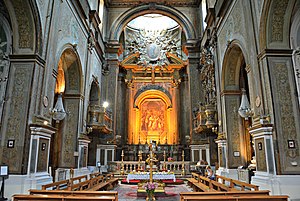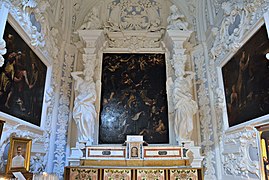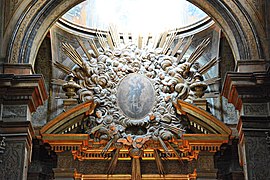Gesù delle Monache
| Chiesa del Gesù delle Monache | |
|---|---|
| Patronage : | Jesus , Mary |
| Order : | Clarissen |
| Address: | Vicoletto Gesù delle Monache, Naples |
Coordinates: 40 ° 51 ′ 16.8 ″ N , 14 ° 15 ′ 23.3 ″ E
Gesù delle Monache (= "Jesus of the Nuns") is the name of a church in Naples , near Porta San Gennaro and Piazza Cavour. As the name suggests, it once belonged to a nunnery and later became known as the parish church of San Giovanni Evangelista a Porta San Gennaro . Like the entire historic old town , Gesù delle Monache is a UNESCO World Heritage Site .
The church should not be confused with the two Jesuit churches of Naples: Gesù Vecchio and Gesù Nuovo .
history
In the 15th century a monastery already existed on the site , which was supported by donations from Queen Johanna II . According to d'Afflitto, they were Sisters of the Terzian Order of St. Francis .
Later, Joanna III, the wife of Ferrante I of Aragon , and her daughter Joanna IV planned to build a church that would become the mausoleum of the dynasty - but these plans could not be realized, partly because of the Aragonese rule over Naples came to an end, on the other hand there was also a lack of funds.
The actual foundation of the church under the name Santa Maria del Gesù took place in 1525 or shortly after the plague of 1527.
It was not until decades later that new supporters were found in Lucrezia Dentice and the Montalto family, and from 1582 the church could be expanded further.
At the end of the 17th century, the building was restored and baroque by Arcangelo Guglielmelli and various other artists .
When the neighboring church of San Giovanni in Porta was demolished in 1862, the church of Gesù delle Monache took over its parish and also the name: San Giovanni Evangelista a Porta San Gennaro .
description
The facade is a very beautiful and typical example of a Neapolitan baroque church. The three floors are divided by fluted pilasters of the Corinthian order from Piperno , which become narrower and more delicate towards the top. The niches in between around the high arch of the portal have a different shape on each floor, round below and rectangular on the middle floor. It contains baroque figures of saints made of white marble : Saint Clara and Saint Anthony of Padua with the baby Jesus (below), the Archangel Michael and Saint Francis of Assisi (center) and in the crowning aedicula a Maria Immaculata . The carved doors of the main entrance date from the 16th century.
The interior consists of a nave with four chapels on both sides. The architectural forms of the main room largely correspond to the original design from the late 16th century. The fluted pilasters on the walls and the columns of the high altar are of composite order. The smooth walls of the entire nave were painted with an unusual illusionistic decor of (seemingly) golden arabesques in the baroque era . The two richly carved gilded galleries above the last arcade in front of the choir room have a very similar, but real arabesque decoration ; on the right gallery is the magnificent baroque organ from the 17th century. The carved and gilded coffered ceiling was renewed around 1680, the majolica floor was created by Nicola Giustiniani around 1670.
Several side chapels were decorated between 1680 and 1683 by Lorenzo Vaccaro and Giuseppe Troise with a typical high baroque, lush and plastic stucco decoration.
The church houses a number of paintings by important Neapolitan painters, most of them by Francesco Solimena : on the entrance facade a representation of St. John the Evangelist and Cardinal Innico Caracciolo (1685, from the destroyed neighboring church of San Giovanni in Porta San Gennaro). In the chapel of St. Clara (second chapel on the right) he painted a cycle about St. Clara from 1681 to 1684 , of which only the two pictures on the altar have survived; two more pictures were lost. The paintings of the Annunciation and the Wedding of the Virgin Mary (1685) in the chapel to the left are by Solimena.
The first chapel on the left was painted by Luca Giordano in 1683, it is an Immaculata with Saints Teresa and Clara , and on the side walls: Saint Anthony preaching to fish and Saint Anthony healing a wounded man .
Among the most important works of art in the church there is also a Madonna and Child and St. Francis, Clara, Peter and Paul by Fabrizio Santafede (1606?), And in the third chapel on the right, some works by Giovan Vincenzo di Forlì: St. Francis receives the stigmata and Saints Francis and Clara . In the fourth chapel on the right you can see a polyptichon from the 16th century.
The apse was redesigned by Arcangelo Guglielmelli around 1680 in the high baroque sense using carved, painted and gilded wood and paper mache . The altar painting of the Circumcision of Jesus (or Circumcision ) by Cesare Turco on the high altar and the two side images by Giovanni Bernardo Lama are from the Renaissance furnishings in the 16th century. Above the high altar, Guglielmelli created an aureole of clouds, angels and rays of light, in the middle of which an oval floats with the baby Jesus by Luca Giordano.
- Picture gallery
literature
- Luigi d'Afflitto: Guida per i curiosi e per i viaggiatori che vengono alla città di Napoli , Volume 1, Naples 1834, pp. 35-36.
- Touring Club Italiano: Guida d'Italia - Napoli e dintorni. Tourung Club Editore, Milan 2008. ISBN 978-88-365-3893-5
See also
Web links
- The “Chiesa del Gesù delle Monache” on the “napoligrafia” website , accessed on March 15, 2019 (Italian; source for this article)
- The "Chiesa del Gesù delle Monache" on Facebook , accessed on March 15, 2019 (Italian)
- The "Chiesa del Gesù delle Monache" on "Youtube" , accessed on March 18, 2019 (Italian)
Individual evidence
- ↑ "Chiesa del Gesù delle Monache" on "tripadvisor" , accessed on March 18, 2019 (Italian)
- ↑ a b c d e f g h “Chiesa del Gesù delle Monache” on the “napoligrafia” website , sub-item: storia ed architettura , accessed on March 15, 2019
- ↑ a b c d Luigi d'Afflitto: "Guida per i curiosi e per i viaggiatori che vengono alla città di Napoli" , Volume 1, Naples 1834, pp. 35-36 (accessed on March 15, 2019)
- ↑ a b c d e f g h i “Chiesa del Gesù delle Monache” on the “napoligrafia” website , sub-item: L'interno , accessed on March 15, 2019








